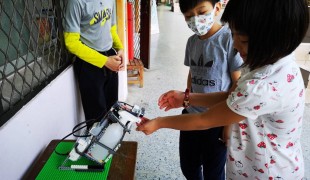- 3862
- 294
- 8
- 7
- 0
- Help Ukraine
About the solution
After years of chronic pain and mobility limitations, Jane knew that something was up. It was not normal to have constant pain and inflammation without anything to pinpoint the source, and this lead her to investigate further and understand where it was coming from. After many months of going to the doctors and getting nowhere, Jane was diagnosed with Ehlers-Danlos Syndrome (EDS), a connective tissue disorder in which the body does not produce the correct collagen, resulting in overly stretchy tissue.
With this diagnosis and the disease progression, she soon realized that her career as a salon owner and hairdresser was coming to an end, as she was reaching a point where she could no longer bear weight on her feet by the end of a workday, and was starting to look for a wheelchair. With this, a multitude of problems came up, with one being quite often on her mind, particularly because, for five months she had non-stop bleeding due to a recent change in birth control.
Menstrual cups seemed to be a promising option, since they had a lot of benefits for her, as there were no more urgent trips to the drugstore to restock tampons, no more changing said tampons multiple times per day, and no more plastic wrappers or applicators ending up in the landfill. This was a dream until they began to cause her further pain.
When looking at the ads, Jane would only see relatively thin, fit, and able-bodied touting menstrual cup usage, which makes them able to reach far enough down and in between your legs to get a cup in and out. People with physical disabilities and/or dexterity challenges, tend to find the body position necessary to insert and remove a menstrual cup significantly more challenging. And this gave her an idea: why not find a way to make menstrual cups a more realistic option for people of all sizes and abilities?
With the help of Andy, a product designer in the medical devices field and a client's partner, they came up with Keela / The Flex Cup!
The “string” (pull-tab) on the Keela / The Flex Cup breaks the seal for the user, pulling the side of the rim down towards the cup’s center and creating an indent that breaks the suction. This allows the cup to be removed almost exactly like a tampon. Even better, the pull tab hangs externally for easier access. This means that even people with reduced mobility have menstrual cups as a true and reliable option.
Learn more about this solution here https://blog.flexfits.com/
this story was adapted from https://blog.flexfits.com/how-keela-joined-flex/
The images were taken from https://medium.com/think-and-zoom/think-and-zoom-future-of-disability-gl..., https://medium.com/@laurenschulte/we-redesigned-divacup-and-periods-will..., as we do not own any of them.
This solution shall not include mention to the use of drugs, chemicals or biologicals (including food); invasive devices; offensive, commercial or inherently dangerous content. This solution was not medically validated. Proceed with caution! If you have any doubts, please consult with a health professional.
DISCLAIMER: This story was written by someone who is not the author of the solution, therefore please be advised that, although it was written with the utmost respect for the innovation and the innovator, there can be some incorrect statements. If you find any errors please contact the patient Innovation team via info@patient-innovation.com
-
-
425
-
0
-
6884

Students create Lego robots to help fight against the new coronavirus
(SELF)-CARE: HYGIENE: Maintaining personal hygiene
Social interaction
Covid19
Assistive Daily Life Device (to help ADL)
Educational/Leisure device (book, toy, game...)
Strategy/Tip
Chest pain or discomfort
Sore throat
Fever
Fatigue
Difficulty breathing deeply
Nasal congestion
Dry cough
Slow breathing (bradypnea)
Sinus pain or pressure.
Shortness of breath
Promoting self-management
Preventing (Vaccination, Protection, Falls, Research/Mapping)
General and Family Medicine
Infectious Diseases
Intensive Care Medicine
Internal Medicine
Pediatrics
Pneumology
Public Health
Taiwan, Province of China
-
-
-
494
-
0
-
11605

Man invents low-cost sanitary pad producing machine
-
-
-
339
-
0
-
4141

Students develop a project to help African women with hygiene
(SELF)-CARE: HYGIENE: Maintaining personal hygiene
Menstruation and Uterine Bleeding
Educational/Leisure device (book, toy, game...)
Body-Worn solutions (Clothing, accessories, shoes, sensors...)
Menstrual irregularities
Anxiety
Muscle cramps or spasms
Enhancing health literacy
Promoting self-management
Preventing (Vaccination, Protection, Falls, Research/Mapping)
Raise awareness
Gynecology and Obstetrics
Public Health
Kenya
-
 en
en